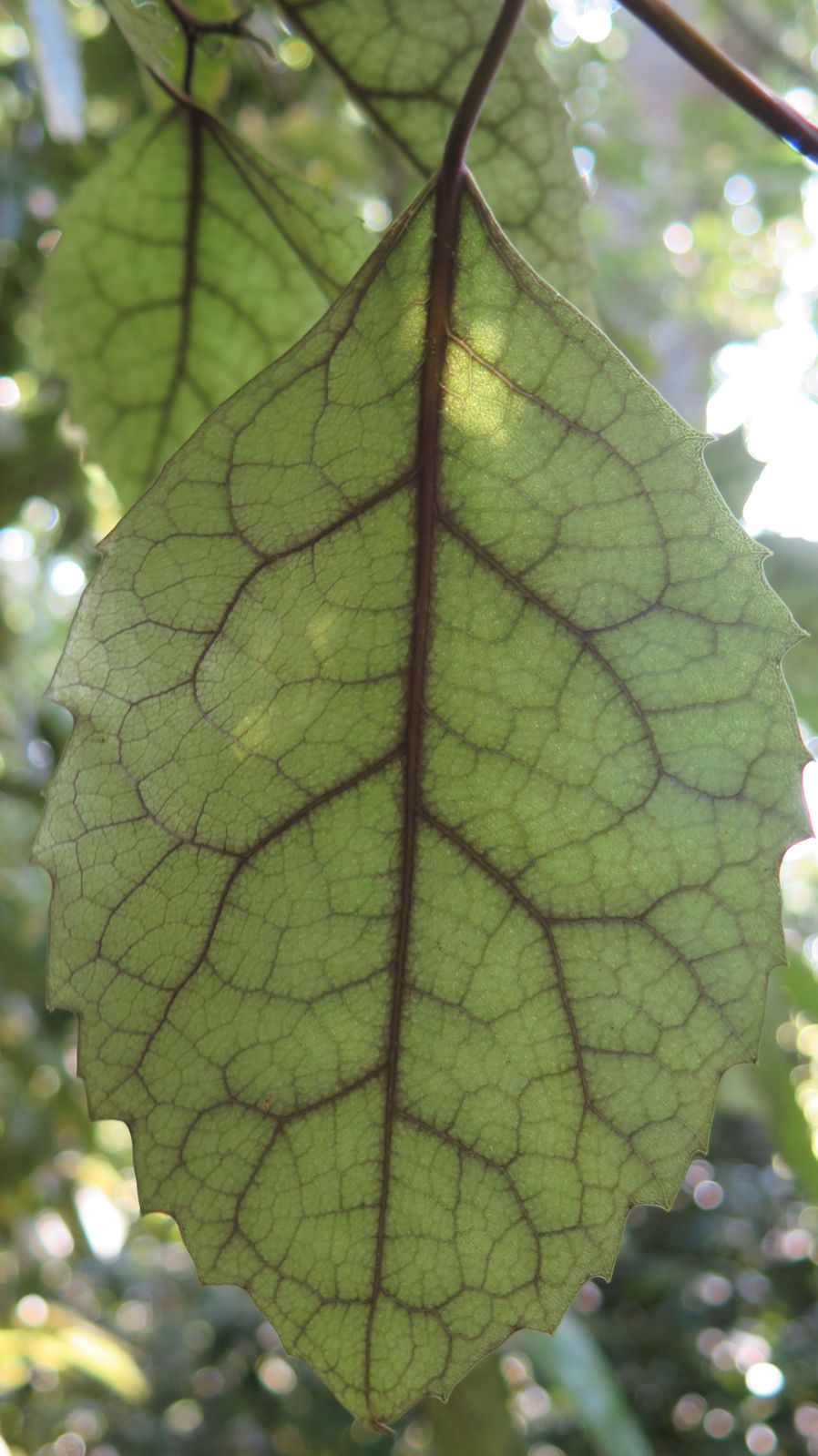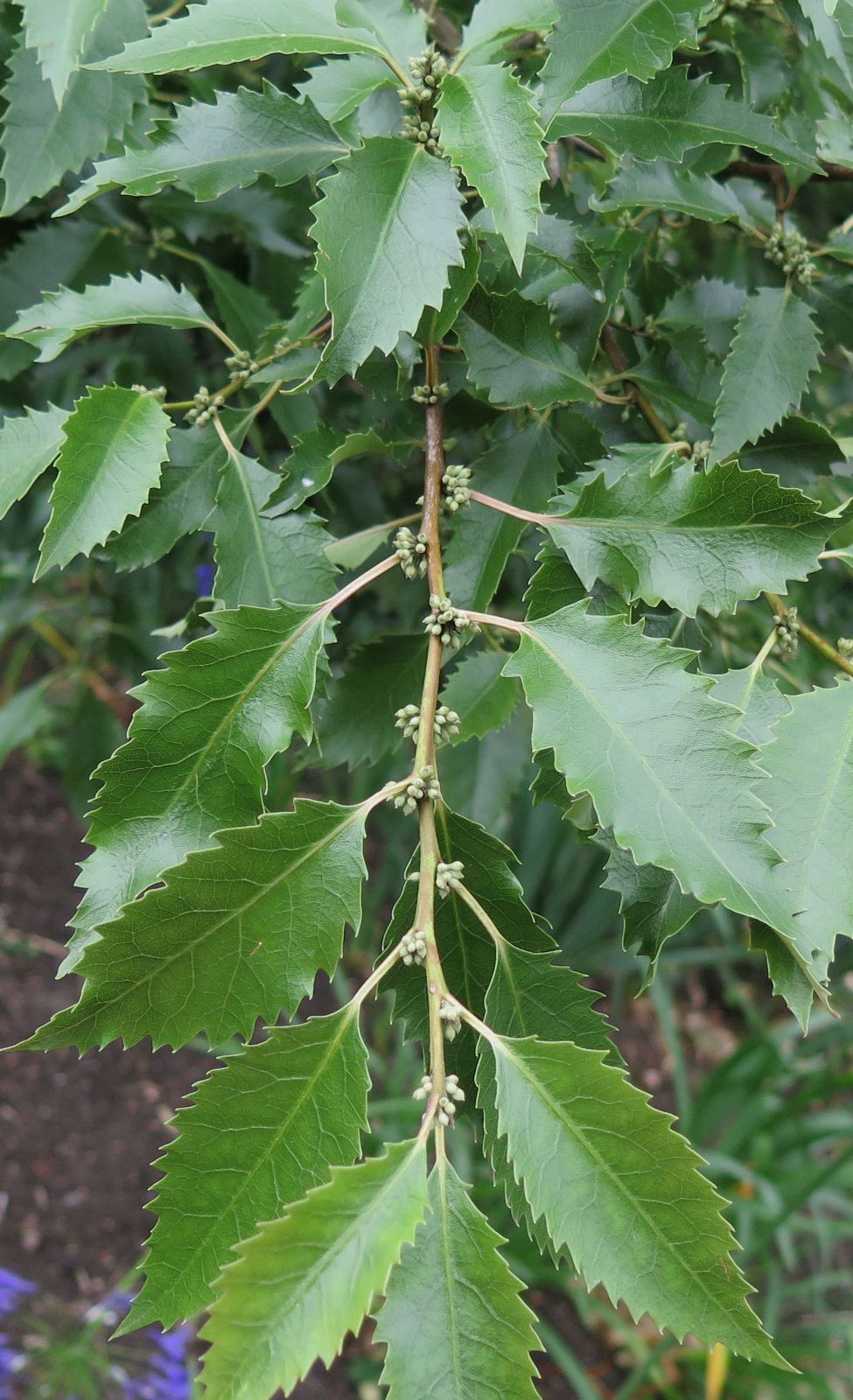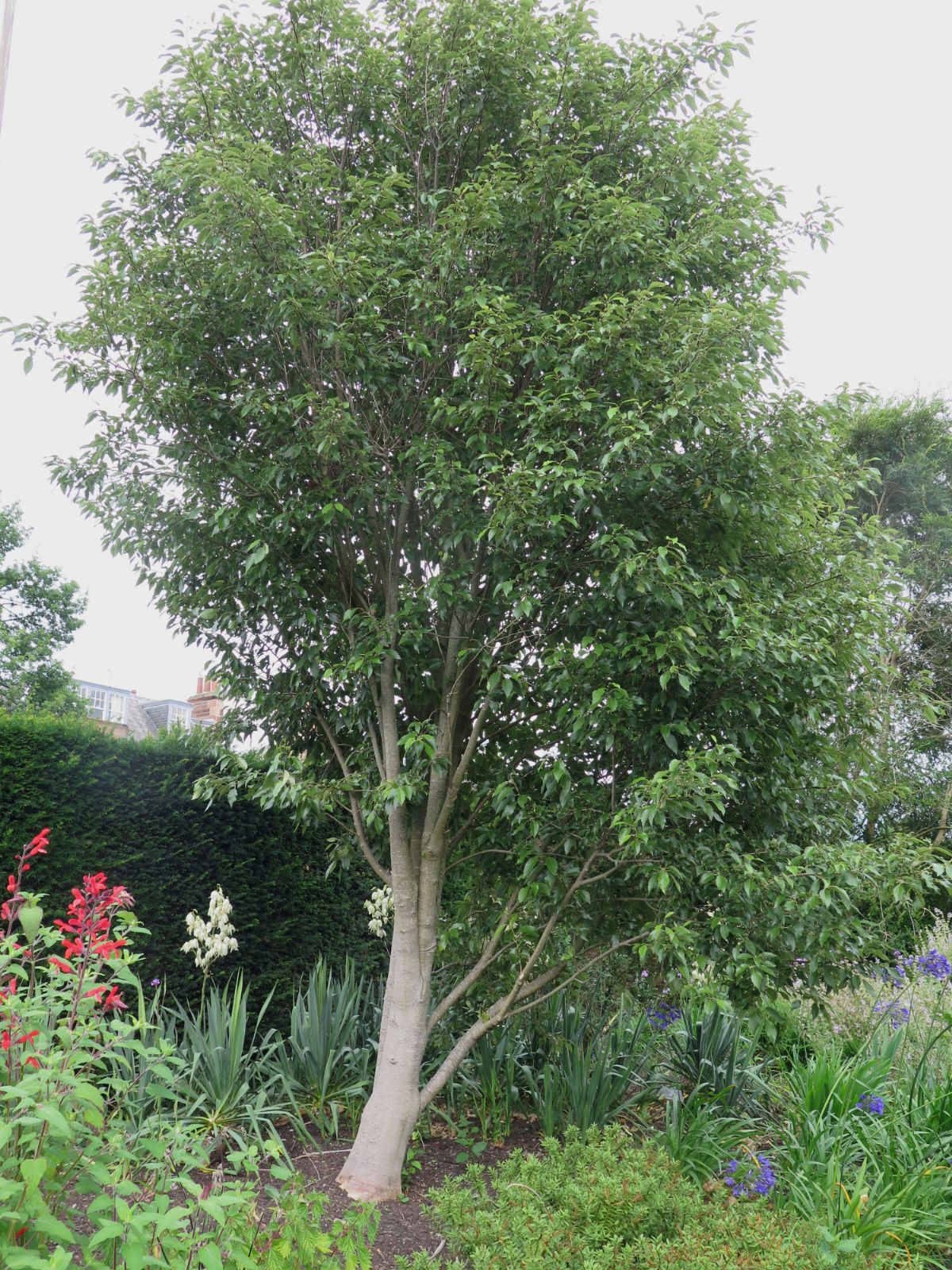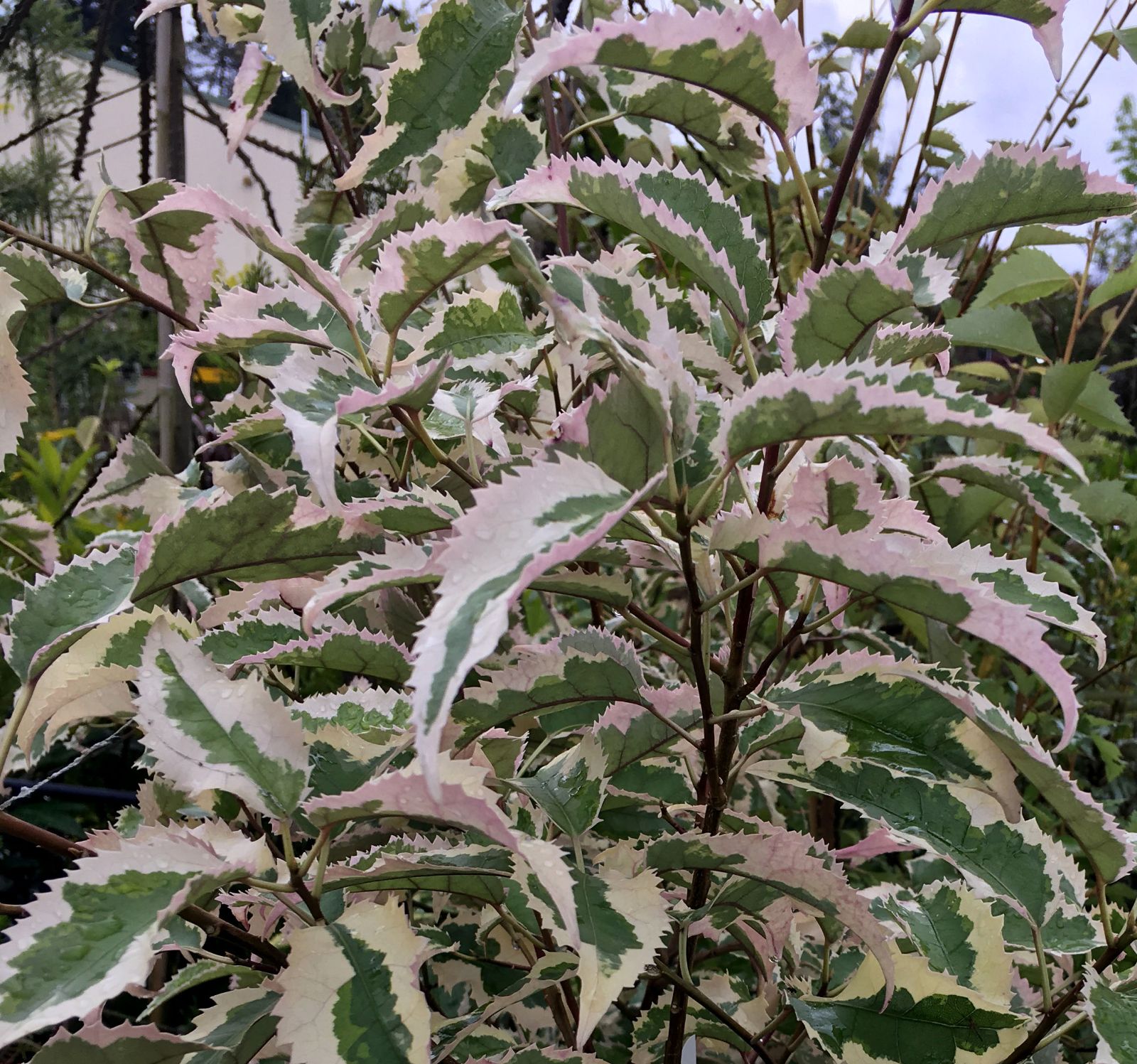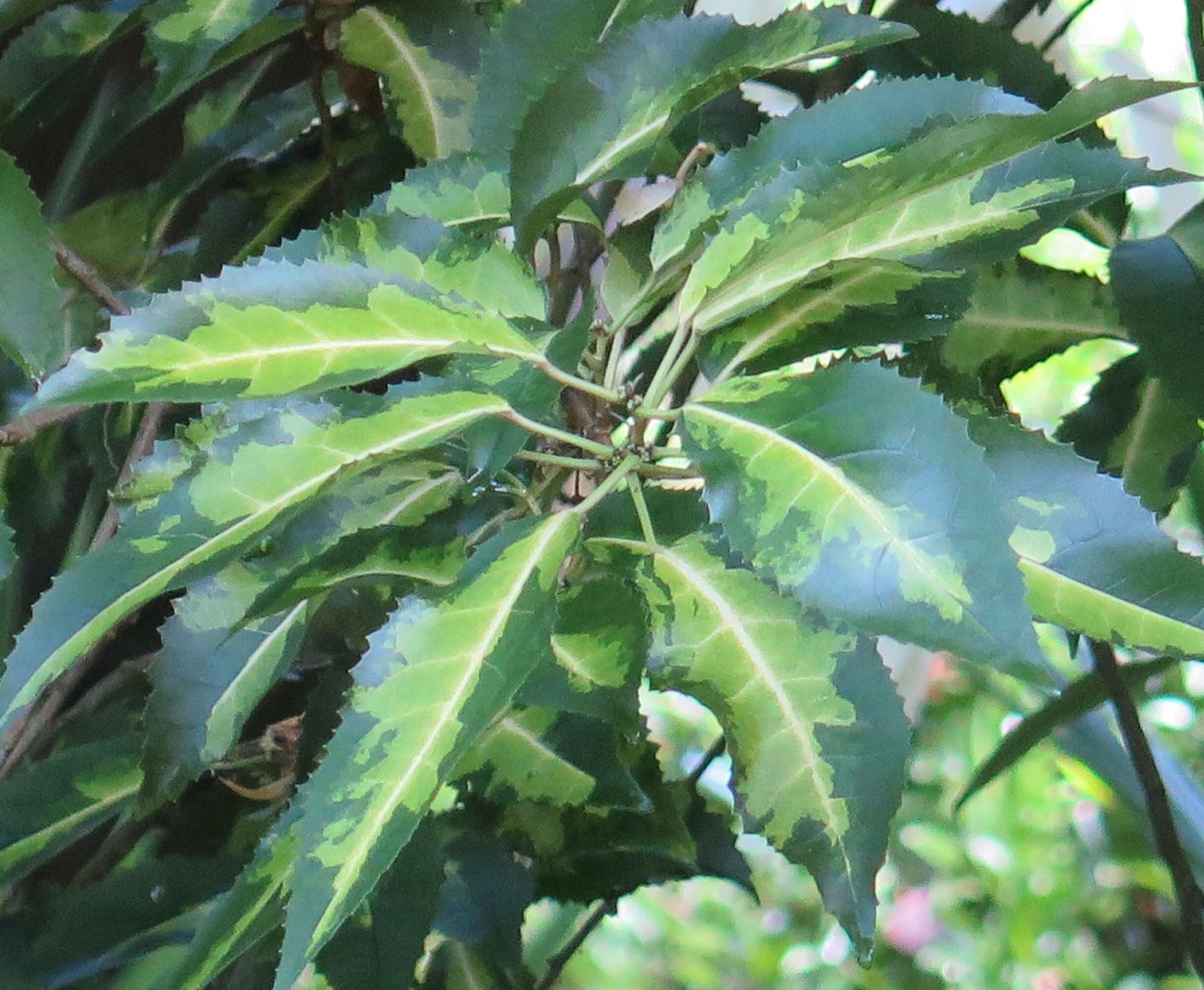Hoheria populnea
Sponsor
Kindly sponsored by
a member of the International Dendrology Society
Credits
Julian Sutton (2021)
Recommended citation
Sutton, J. (2021), 'Hoheria populnea' from the website Trees and Shrubs Online (treesandshrubsonline.
Genus
Common Names
- Lacebark
- Houhere
- Ribbonwood
Synonyms
- Hoheria sinclairii Hook. f.
- Sida hoheri Hook.
Small, rarely medium, evergreen tree to 8(–11)m, not usually heteroblastic. Branchlets slender, grooved, with pale grey bark; with stellate hairs when young. Leaves of adult plant sometimes a little leathery; leaf blade broadly ovate to ovate-lanceolate or elliptic, (5–)7–14 × (3–)4–6 cm; apex acuminate (rarely acute, obtuse or rounded); base rounded, truncate or subcordate; margin deeply, coarsely, sometimes doubly, serrate-dentate; ± glabrous; petiole to ~2 cm. Juvenile plant usually similar in leaf form to adult. More rarely, juvenile plant with branchlets very slender, divaricate, ± entangled; leaf blade broadly-ovate to deltoid or suborbicular, (5–)10–30 mm long; margin serrate, ± deeply lobed (teeth sometimes crenate); petiole very slender, to 10 mm. Flowers ~25 mm across, both solitary and in (2–)5–10-flowered cymose clusters on same plant; pedicels ~10 mm, with stellate hairs; calyx campanulate, ~5 mm long, teeth triangular; petals ~10 mm long, white; stigmas capitate. Mature carpels 5(–6), compressed, 5–7 × 5–7 mm including broad wings. Flowering September (UK). (Allan 1961; New Zealand Plant Conservation Network 2021)
Distribution New Zealand N North Island, more widely naturalized
Habitat Coastal and montane forests dominated by Agathis australis or Metrosideros excelsa, 0–460 m.
USDA Hardiness Zone 9-10
RHS Hardiness Rating H3
Conservation status Not evaluated (NE)
This is the most tender of the Hoheria species in general cultivation. Widely grown in New Zealand, mature specimens are rarely seen in our area outside the mildest British and Irish gardens. Flowering later than other species, it can be very striking in the early autumn garden. All known variegated hoherias also belong here.
Among the evergreen species in cultivation, H. populnea is distinguished from both H. sexstylosa and H. angustifolia by its broader, more coarsely serrate leaves (though quite variable in shape) which often have purple-tinted veins. Its flowers are a little larger, appearing clustered towards the tips of the branches. It also tends to flower later than these species, usually in September in Britain, and is valued by New Zealand beekepers as a late source of nectar and pollen (Newstrom-Lloyd & McPherson 2017). Closely related to H. populnea is the more recently described H. equitum Heads (not cultivated in our area and probably very tender), restricted to the northerly Poor Knights Islands and Hen and Chickens Islands. It differs in its leathery leaves being untoothed, or almost so, often with recurved margins; its flowers tend to be smaller (Heads 2000).
This was the first Hoheria described scientifically, by Allan Cunningham from specimens collected around the Bay of Islands in 1825 and 1833; the collectors were Charles Fraser and later Richard Cunningham (Allan’s brother), successive Colonial Botanists of New South Wales, both of whose explorations included visits to New Zealand. The original description notes that it is ‘a large shrub, of agreeable aspect, and very ornamented growth’ (Cunningham 1839). It was certainly grown in the British Isles by the turn of the 20th century, when it flowered at Trinity College Botanic Garden, Dublin (Bean 1914). Early reports make it clear that this was not a fully hardy tree away from the mildest parts of the British Isles. Arnold-Forster (1948) noted that while in his own mild if exposed West Cornwall garden it belonged ‘in the first rank of flowering trees’, many examples elsewhere were killed or damaged in the severe weather of December 1937. Large examples in the British Isles include trees at Garnish Island, Co. Cork (16 m × 179 cm, 2004) and Trengwainton, Cornwall (16 m × 70 cm, 2014). It is no surprise that another Irish specimen at Fota Arboretum, Co. Cork (14 m × 153 cm, 2017) was planted in 1948, following the devastating winter of 1946–7 (Tree Register 2021). Fast growth, availability of nursery stock and often milder winters mean that even in less favoured areas this is becoming a species worth considering for short- to medium-term garden use. For example, a tree planted in 2005 in the Queen Mother’s garden at RBG Edinburgh has made an upright and floriferous specimen in full sun (pers. obs. 2021).
We have been unable to find records of H. populnea growing unprotected in other parts of Europe, or in our North American area. It would seem worth trying in coastal Brittany, Washington and Oregon, and perhaps in the American Southeast.
Several cultivars have been selected, mostly in New Zealand. The main sources of reference for these are the catalogues of North Island nurserymen Duncan & Davies from the 1920s onwards (available online at Royal New Zealand Institute of Horticulture 2020), and Hutchins (2006). In addition to those below, Duncan & Davies listed several distinct leaf forms around 1930, under spurious varietal names later treated as cultivars by Hutchins. The most interesting were perhaps var. linearis / ‘Linearis’ with distinctive narrow foliage and an open habit, and var. macrodonta / ‘Macrodonta’ with deeply toothed leaves giving a slightly holly-like appearance. These appear to be defunct.
'Alba Variegata'
Synonyms / alternative names
Hoheria populnea 'Alba'
Hoheria populnea 'Alba Marginata'
Hoheria populnea 'Variegata' misapplied
Leaves with a broad, irregular, creamy white margin, flushed pink when young, a vivid effect. A sport on ‘Variegata’ found in 1920s New Zealand, first listed by Duncan & Davies in an undated catalogue from around 1930 (Royal New Zealand Institute of Horticulture 2020); later catalogues described it as suiting damp or semi-shaded positions in a New Zealand context. At Caerhays Castle, Cornwall, UK – a very mild coastal garden – both this and ‘Variegata’ ‘defoliate a bit in the slightest frost, despite being very well sheltered and mollycoddled’ (Williams 2021, entry for 2nd October 2015).
Purple-leaved Cultivars
A confusing range of forms – some named, some not – have a degree of purple coloration to the underside of the leaves. It is possible that they all derive ultimately from the same wild find, ‘Osbornei’. None seem to have a purple upper surface.
- ‘Osbornei’ Undersurface usually described as ‘purplish’. On its commercial release by Duncan & Davies in 1926, the phrasing was merely ‘dark veined beneath’, but this changed in later years. The stamens are bluish-purple. Found in about 1910 on the northerly Great Barrier Island; the property owner’s name was Osborne.
- ‘Foliis Purpureis’ (‘Purpurea’) A seedling from ‘Osbornei’ raised by Duncan & Davies, introduced 1930. The undersurface was described as ‘a beautiful copper colour’, but Hutchins (2006) uses the phrase ‘deep purple’.
- ‘Purple Shadow’ Uppermost leaves purple beneath; very late flowering, in early October (Essex, UK). Selected 2004 by Graham Hutchins from a batch of variable H. populnea seedlings, perhaps from ‘Osbornei’. The seed came from a Christchurch, New Zealand, garden. Distributed by County Park Nursery, Essex, by 2008.
Other unnamed clones – perhaps seedlings from the cultivars – are in circulation under one or another of these names and synonyms. Hutchins (2006) found several different plants in British nurseries, none of them with blue stamens, but Ben Probert has found one example (labelled ‘Osbornei’) in a private Devon garden (pers. comm. 2021). Outside New Zealand, large examples of these rather tender plants are rarely seen. Bean (1981) mentions ‘Osbornei’ growing on Garnish Island, Co. Cork, Ireland, while a tree of 10 m × 154 cm was recorded in 2006 labelled “Hoheria purpurea” at Heligan, Cornwall (Tree Register 2021): these are both notably mild gardens.
'Variegata'
Synonyms / alternative names
Hoheria populnea 'Aurea Variegata'
Hoheria populnea 'Sunshine'
Leaves variegated; margins dark green, contrasting with an irregular yellow-green central zone. Origin New Zealand; described as ‘new’ in the 1926 Duncan & Davies nursery catalogue, with the comment that it is fast growing and ‘best seen against a green background’ (Royal New Zealand Institute of Horticulture 2020). There is an impressive example at Abbotsbury Subtropical Gardens, Dorset, UK, planted in the early 1990s from a batch of liners imported from New Zealand (S. Griffith pers. comm. 2021).

